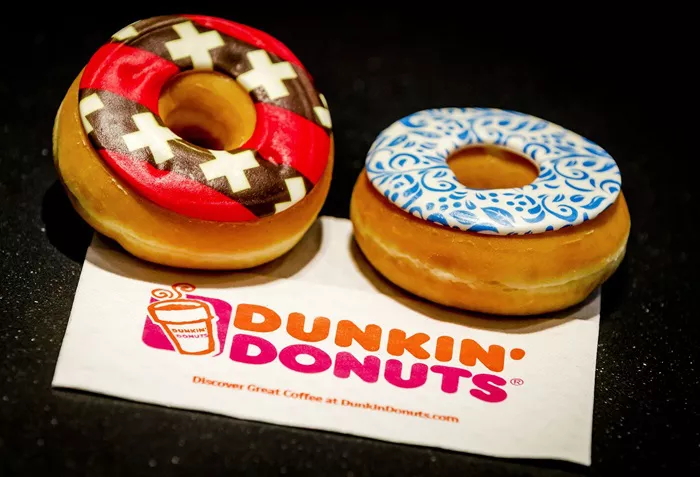Donuts have long been a beloved treat, and Dunkin’, one of the most recognizable names in the industry, is known for producing consistent, high-quality donuts. Understanding how Dunkin’ makes its donuts reveals a process that combines tradition, technology, and attention to detail. This article delves into the steps and techniques Dunkin’ employs to craft their famous donuts.
1. Selection of Ingredients
High-quality flour
Dunkin’ begins with high-quality all-purpose flour. This flour forms the base for the dough, providing structure and ensuring the donuts are light and fluffy.
Sugar and sweeteners
Sugar is a critical ingredient, not only for sweetness but also for feeding the yeast used in the dough. Dunkin’ balances sweetness to create a satisfying flavor.
Dairy and eggs
Milk and eggs enrich the dough, contributing to its soft texture and moisture. These ingredients also enhance the flavor profile of the donuts.
Yeast or leavening agents
For most donuts, yeast is used as a leavening agent, giving them their airy and soft texture. Cake donuts, however, rely on baking powder or baking soda.
2. Mixing and Preparing the Dough
Precision in mixing
The mixing process is carefully controlled to ensure consistency. Dunkin’ uses industrial mixers that combine the ingredients to create a uniform dough.
Dry ingredients are sifted to remove clumps.
Wet ingredients are added slowly to achieve the right consistency.
The dough is kneaded for just the right amount of time to develop gluten without overworking it.
Resting the dough
After mixing, the dough is allowed to rest. This period lets the gluten relax and the yeast activate, causing the dough to rise. Resting is essential for achieving the light texture Dunkin’ is known for.
3. Shaping the Donuts
Dough rolling and cutting
Once the dough has risen, it is rolled out to a specific thickness. Dunkin’ uses specialized cutters to shape the donuts. These cutters create uniform rings or other shapes, such as filled donuts or twists.
Automated precision
In Dunkin’s facilities, automated machinery ensures consistency in size and shape. This precision guarantees that each donut cooks evenly and maintains its signature look.
4. Frying: The Key to Perfect Texture
Oil selection
Dunkin’ uses high-quality frying oil with a high smoke point. The choice of oil impacts the flavor and texture of the donuts.
Controlled temperatures
The donuts are fried at specific temperatures, usually around 350°F (175°C). Precise temperature control ensures the donuts cook evenly, developing a golden-brown exterior while remaining soft inside.
Frying time
Donuts are fried for a set amount of time on each side, typically 45–60 seconds. This timing creates the perfect crust and prevents the donuts from absorbing too much oil.
5. Filling and Glazing
Filled donuts
For varieties like Boston Cream or Jelly Donuts, the filling is injected after frying. Dunkin’ uses specialized equipment to ensure the filling is evenly distributed.
Glazing process
The donuts are coated with glaze or icing while still warm. This allows the topping to adhere properly and form a shiny, smooth layer.
Classic glazed donuts are dipped in a sugar-based glaze.
Frosted donuts are coated with thicker icings, often followed by a sprinkle of toppings like rainbow sprinkles or nuts.
Specialty decorations
Seasonal or themed donuts feature intricate decorations. Dunkin’ employs skilled workers or advanced machinery to apply designs consistently.
6. Quality Control
Visual inspection
Each batch of donuts undergoes a visual check to ensure uniformity in color, shape, and topping application.
Taste testing
Dunkin’ maintains high standards by performing regular taste tests to confirm that the flavor profile meets their guidelines.
7. Packaging and Distribution
Freshness preservation
Donuts are packaged carefully to maintain freshness. Dunkin’ employs packaging that protects the donuts from drying out while allowing some ventilation to prevent sogginess.
Delivery to stores
Dunkin’ donuts are often prepared in central kitchens and delivered to stores daily. This model allows for efficient production while ensuring freshness.
8. Innovations in the Process
Embracing automation
Dunkin’ has integrated modern technology to streamline its production process. Automated fryers, precision cutters, and glaze applicators improve efficiency and reduce waste.
Experimentation with flavors
Dunkin’ continually experiments with new flavors and designs, keeping their menu exciting and catering to diverse customer preferences.
9. Sustainability Practices
Eco-friendly initiatives
Dunkin’ is committed to sustainability, sourcing ingredients responsibly and exploring eco-friendly packaging options.
Waste reduction
By optimizing production processes, Dunkin’ minimizes waste during both preparation and packaging stages.
Conclusion: A Blend of Art and Science
Dunkin’ donuts are the result of a meticulous process that blends traditional baking methods with modern technology. Every step, from selecting ingredients to delivering fresh donuts to stores, is executed with precision. By maintaining high standards and embracing innovation, Dunkin’ continues to delight customers with its iconic treats. Whether you prefer a classic glazed donut or a creatively designed seasonal option, you can trust that Dunkin’ has perfected the art of donut-making.
Related Topics:

